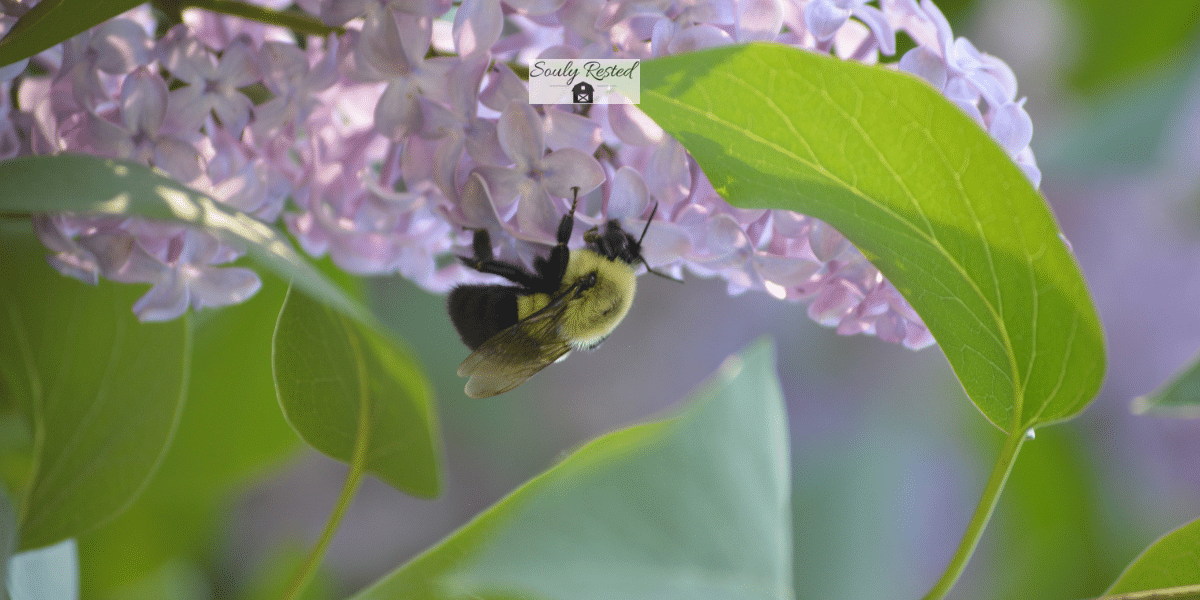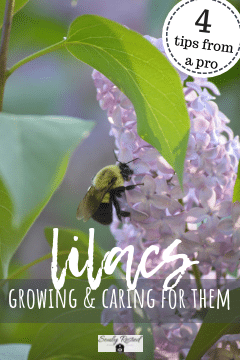Last Updated on June 20, 2024 by Michelle
How do I care for my lilacs? I asked a pro for some advice that I could share with y’all. Cause, well, everyone should have a lilac bush. Or two. Or ten.
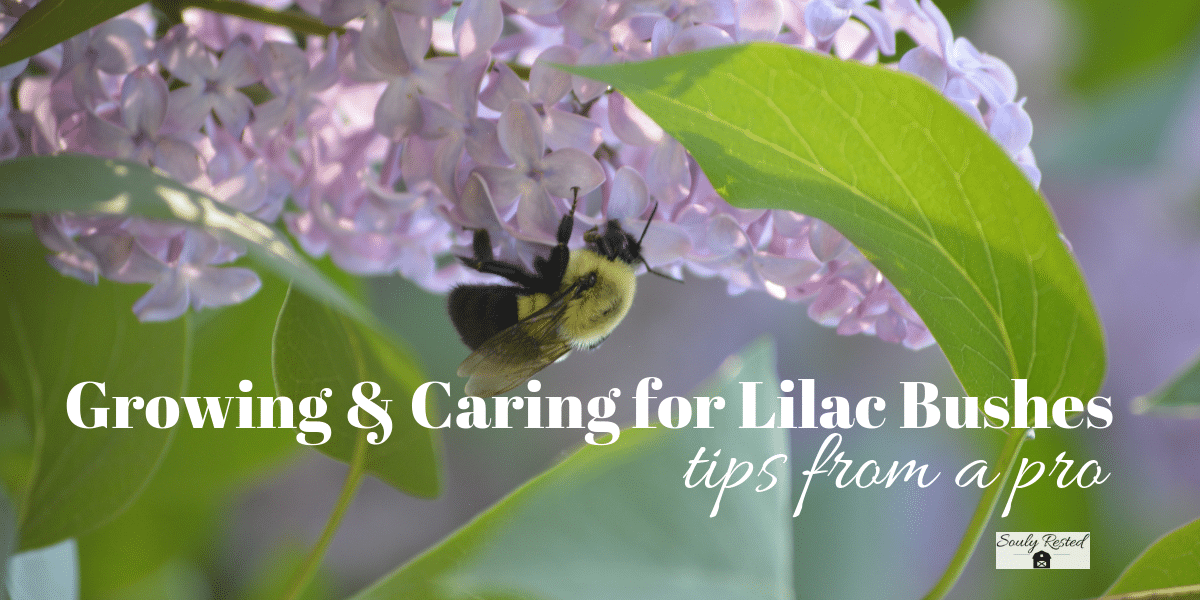 This post contains affiliate links.
This post contains affiliate links.
It turns out that lilac care really couldn’t be much simpler. Growing and caring for lilac bushes? Sounds like anyone can do this. No wonder my lilacs here around my old farmhouse have survived for a hundred years or more. Read here about my old, treasured lilacs. And then pick up a copy of my new book–Sweet Maple–for more information about lilac syrup. (aff link)
My newest lilac love? I planted these Bloomerang lilacs last fall, and I am very impressed.
Ed Laivo of NatureHills.com is joining us again today to answer all my questions about my beautiful lilacs.
You’ll want to be sure to glance at yesterday’s post too, about how and why to plant shrubs in the fall. But first, let me tell you a little about Ed in case you missed it yesterday…
Ed Laivo has over 40 years of extensive varied experience in plant production and nursery management. Ed is a fruit tree and edible landscaping specialist who has been involved with the introduction or reintroduction of many popular varieties of fruits including figs, Pomegranates, and Blueberry varieties to the home gardener, introducing techniques to better adapt these to the backyard grower. Ed has been a frequent guest on numerous TV and radio shows, as well as a popular writer, contributing insightful articles to many popular gardening periodicals.
–> If you order from Nature Hills, for a limited time you can take $20 off any purchase over $100 if you use this link and enter coupon code SR20. <–
So thanks so much for joining us today, Ed! I’ll start firing away my questions…
What’s important?
Q: What are the most important things I should I know about lilacs?
Ed’s Answer: Lilacs are fairly easy to grow, but you should know these few, but important, facts.
- They need full sun. To enjoy the most flowers possible, always plant lilacs in full sun.
- They need the right soil. It must be well drained soil, no exceptions.
- They don’t need much fertilizer, if any. So always go easy on the fertilizer, being especially careful not to spray any high nitrogen lawn fertilizers near the roots of your lilac plants, as it can prevent flower production.
- They love a good pruning every year. You’ll want to prune your lilacs right after the spring flowers have died. Finish removing the old flower heads and shorten up any stems that got out of hand.
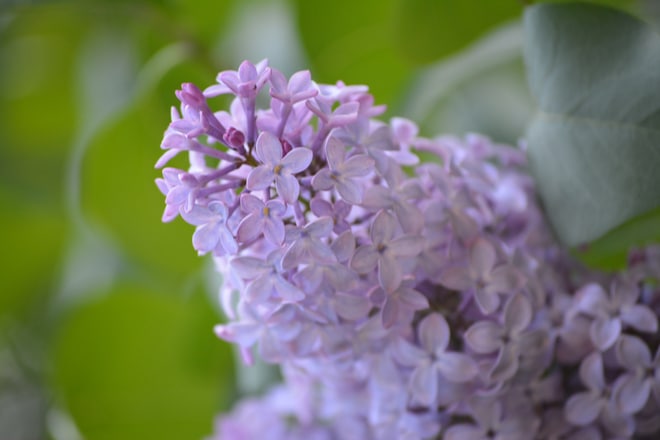
Pruning
Q. Should lilacs be pruned often?
Ed’s Answer: It’s really only needed once a year. But in addition to the spring pruning of dead flowers, lilacs can also be renewal pruned. Simply remove the oldest, fattest stems, right down to the ground That will allow the nice, younger stems to remain and flower for the next year. Pretty simple!
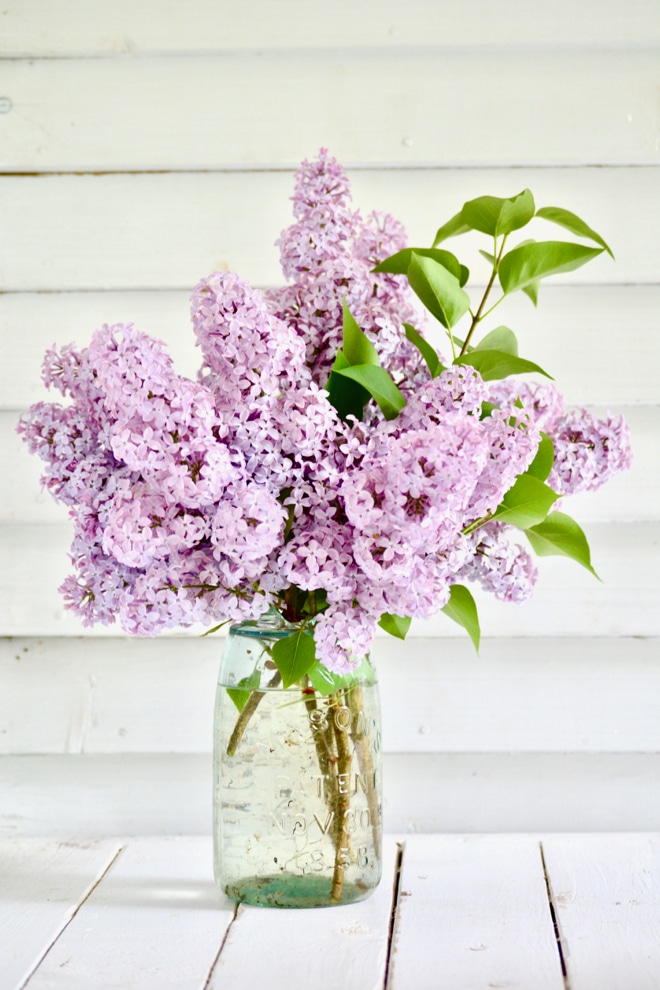
Lilacs in the fall
Q. You shared some great tips yesterday about planting shrubs (including lilacs!) in the fall, here in New England. Are there certain things I should do in the fall for my established lilacs?
Ed’s Answer: The hardiness of lilacs make it a simple plant when it comes to preparing them for winter. Your newly planted or your established lilac plants may appreciate a bit of mulch over the roots, but not up against the stems of the plants. That’s it. They should come through the winter beautifully.
Varieties of Lilacs
Q: Can you explain to me a little about all the different lilacs varieties so my readers can decide which ones are best for them?
Ed’s Answer: There are many different kinds of lilacs. The common purple and white lilacs and all of the French hybrid lilacs are super hardy and can be planted in very exposed areas without any scare of winter damage. This group of lilacs are larger growers and will appreciate having the room to grow. There are a huge number of selections offering a myriad of colors from white, to pinks, blue, lavenders, and the darkest of purples. These lilacs are excellent for including in windbreaks and shelter belts. Imagine a backdrop of evergreens with a monochromatic planting of one lilac, or maybe a mix of French hybrid lilacs in front. Brilliant.
The dwarf group of lilacs like Miss Kim and Dwarf Korean Lilacs bloom profusely on smaller plants and the blooms follow the French hybrids. Newer introductions included here are the reblooming selections that the new Bloomerang® lilacs offer; this is the variety you chose, Michelle, and I love them. The Bloomerang® selections bloom in spring and then again after they put on a flush of growth and the flowers come again later in summer or into fall. A huge bonus!
Another variety of lilac that are easy to grow are the Canadian hybrids. Royalty, Miss Canada, and James Macfarlane are all beautiful shrubs that do not sucker like the French hybrids do. This group of beauties doesn’t even start blooming until the French hybrids are done blooming – a way to extend the lilac flowers available in your yard.
We would be remiss if we did not mention Japanese tree lilacs to round out the latest of the blooming lilacs. We grow some as multiple-stem shrub form and the Ivory Silk as single-stem smaller trees. The wildly showy creamy white flowers are spectacular.
Other shrubs in New England
Q: So I know I love lilacs. What other shrubs would you recommend I consider here on my New England homestead?
Another excellent group of plants for fall transplanting is Viburnum. Oozing with class and something to offer in all seasons, these shrubs flower in spring, fruit in summer and fall, and then offer a fall color you will love. Viburnums– typically known as large scale plants are great for screening and snow fencing–have evolved with many new smaller growing selections. They are definitely worth checking out.
Oh, and one more option for cold areas is a very old fashioned native known as Black Chokeberry (Aronia melanocarpa), and a few other species and selections. The Black Chokeberry produces flowers in spring on last year’s stems, the clusters of black fruits ripen and are ready to harvest in late August. A distinguished fall color exhibiting orange, purple and red is first rate. Super hardy and easy to transplant in fall. The best part about Black Chokeberry is their super fruit quality. Their berries are over 340% higher in antioxidants than blueberries. You can freeze the berries and use them for baking, cooking, and tossing in smoothies. The flavor of the berries is somewhat astringent and would remind you of the flavor of red wine. Certainly one worth including in your edible landscape.
I truly can’t say “thank you” enough to Ed for taking time out to share his knowledge.
And I can’t recommend any online nursery resource other than Nature Hills, cause they’re amazing and they are they only one I will use from this point forward.
If you enjoyed my recent discoveries of all that lilacs can do for us in the kitchen even half as much as I did this last summer, you may want to check out Nature Hills. You too can have a box of wonderful lilac bushes on your own front porch by the end of the week.
How to make lilac cuttings last longer?
Once you have some established lilacs, you’ll want to fill your home with lilac bouquets every spring. But the blooms don’t last too long, so you’ll want to follow these tips to extend the life of your cuttings:
- Pick flowers in the cool of the morning or evening.
- Cut each stem at an angle.
- Choose stems that have most of the flowers open… lilacs open very little after being cut.
- Remove some of the leaves (I like the look of them in the vase, so I will leave some on) so the plant isn’t putting too much effort into hydrating the leaves.
- Place your cuttings in a bucket in a cool spot and let the stems take up water for an hour or so, before the next step.
- Lay each stem on a solid surface and, using the handle of your clippers or a small hammer, pound the bottom inch or so of the stem. This pulls back the bark from the stem, so it can get adequate water.
How to make delicious lilac sweeteners:
Here’s one about lilac sugar.
Then there’s lilac simple syrup. And that post includes a full video tutorial.
Go here for how to download sweet printable gift tags for lilac simple syrup.
Make lilac shortbread
Oh, and absolutely don’t miss the lilac-infused honey.
And more lilac information:
Here I share my favorite-of-all-time Lilac Blueberry Kombucha recipe.
This post is where my lilac obsession all started. With one of my favorite history lessons ever.
And I can’t recommend enough that you check out Nature Hills Nursery for their amazing lilac bushes & more.
And watch this little video to find out the latest delicious way I’ve been using my lilac blooms!–>
Then check out another great use for lilac blooms (lilac-infused honey for my home-grown mint tea!)–>
The earth is full of His unfailing love. [And I truly believe the lilac is one proof of His love.] Psalm 33:5
Find out why SoulyRested was considered to be one of the Top 20 Must-Read Homesteading Blogs of 2018 and then one of the Top Homesteading Blogs of 2019 as well.
I’d love to connect!
To find me in some other neck of the woods, just click any (or every!) icon below:
And please follow along!


